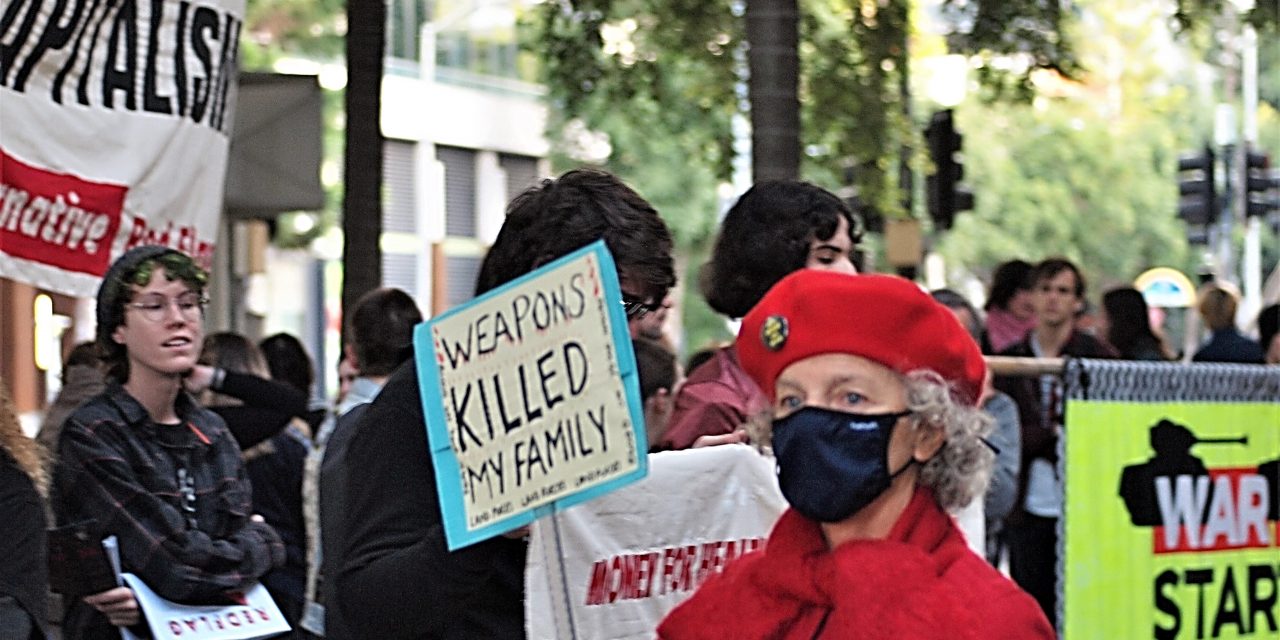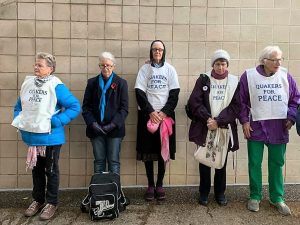The Land Forces weapons expo held at the Brisbane Convention Centre from June 2-4 has packed up and rolled out. The weapons manufacturers will be going home to assess how many potential investors they’ve managed to attract to help develop more efficient ways to kill human beings, how many new customers they might have found to whom they can sell these new, improved weapons, and how many university students might be enticed to come and work for them.
At 7am on the first morning of the expo, red liquid was being hosed off the steps of the convention centre in a number of places. It flowed away along the path, pooling among the protesters who had gathered with their vuvuzelas, whistles, pots and pans, and megaphones, ready to disrupt and make as uncomfortable as possible those attending the expo. Making the fake blood disappear was indicative of the steadfast determination to deny the reality of what was being exhibited, paid for by public money, justified by the “thousands of jobs it will create”, and the need to protect Australia from a war with China that politicians are almost willing into being with their grim warnings: the fact that the products on show are for killing human beings.
On Wednesday I donned a cunning disguise of stockings and high heels and headed down to see what was going on inside. As I walked up to cross at the lights I saw two protesters heading there too. “Hi guys,” I said. “I’m on your side but I’m going in there today so please don’t yell at me as I go in.” They thanked me for infiltrating but said if they didn’t yell and swear at me it would look suspicious, so as I crossed over to the entrance one of them yelled, “Are you going in there too are you? Well fuck you! Have a good time.”
Once inside I looked through the glass at the protesters below, chanting and yelling and holding banners that said “War: Good for Some, Bad for Most”, “Money for health and education not war” and two children holding a sign that said “All wars kill kids”.
At the Boeing industry briefing the powerpoint presentation sought to entice investors by promising “Safety above all else, fair competition, embracing diversity, ethical dealings at all levels, prompt payment”. At the top of each slide was their slogan: ‘Connected, Protected, Enabled, Lethal’. Probably not the slogan used for their passenger airline arm.
Heading out I saw Brendan Nelson, former Liberal party leader and now President of Boeing Australia, New Zealand, and South Pacific. “Mr Nelson,” I called to him and, ever the politician, he responded with “Brendan,” and stretched out his hand. I introduced myself and asked him what he thought of the protesters outside. He said he respected anyone who acted on their convictions and their right to protest, but that they should be grateful they live in a country where they are free to do so, thanks to the men and women in uniform, one of whom he indicated standing nearby. I said the protesters were objecting to money being made from weapons manufacturing. He said companies were obliged to honour the risks investors take and provide dividends, and that thousands of jobs were being created. I asked him what he thought about Australia exporting weapons to countries like Indonesia who are accused of genocide in West Papua. He said he couldn’t comment and began backing away.
The main hall was a sea of men in navy blazers and full military regalia, with a few women here and there. There were large guns, missile launchers, tanks, and big and small screens showing footage of what this hardware could do to things like brick walls. Tanks raced across desert landscapes and things exploded.
I examined a display of different-sized bullets and models of missiles on the Nioa stand. I scrambled up the ramp of a Rheinmetall tank in my heels and ducked inside. “There’s a lot more room in them than there used to be,” an ex-soldier remarked. In about an hour several protesters would surge into the hall and climb onto this tank, one bolting himself on the front with a D-Bolt around his neck. For now it was being inspected like a new toy.
Next to the roomier tank was a smaller, unmanned prototype. We were told it would have the AI capability to tell friend from foe in the same way an army or police dog will be calm if it sees someone in uniform but attack someone in civvies. This would help reduce civilian casualties.
There was the body armour produced by Chiron Global Tech, designed to withstand enormous force. “How much force?” I asked. “You could hit me with a sledge hammer,” the guy modelling it replied.
I spoke with a nurse who worked for a company that supplies medical equipment to the military. “What do you think about the protesters?” I asked her. “Oh they’re trying to make us feel guilty or something. I don’t know what about,” she said. “About killing people?” I suggested. “Yeah, killing people, starving people,” she said, rolling her eyes.
Outside next morning, I stood with the now depleted numbers of protesters; many had been arrested and their bail conditions prohibited them from coming within 500 metres of the Convention Centre. We sang “We Shall Overcome” and a few other rousing tunes for about an hour then decided to go for coffee at the nearby Tafe. A couple of the women, grey-haired Quakers, carried banners, attracting stern looks from security guards and eventually a bicycle ride-by by the cops.
“We must look very dangerous,” I remarked to one of the women. “Yes,” she replied. “‘What did you do at the expo this morning? Sang some songs then went for coffee’.”
Meanwhile, a couple of hundred metres away people were selling machines designed to most effectively and efficiently kill humans or, to use the common euphemism used by the weapons industry, “soft targets”.
Images by Rose Lane and Jan Bowman








